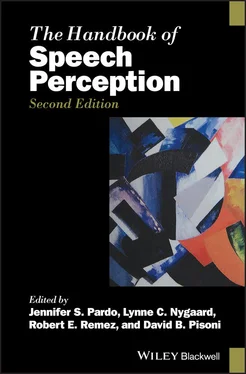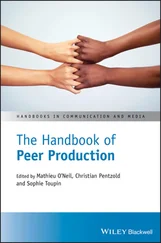The result of ‘kick’ and ‘lick’ is of fundamental importance because it gives us a leg up, so to speak, on the very difficult problem of trying to understand the representation of semantics in the brain. Of course, not all words are grounded in embodied semantics in the same way. For example, some words are abstract. Consider the word ‘society.’ Questions like “What does a society taste like?” or even “What does a society look like?” are difficult to answer, because societies are not the kinds of things that we taste or see. Societies are not like strawberries. But even abstract words like ‘society’ may contain embodied semantics that become apparent when we consider the ways in which metaphors link abstract concepts with concretely experienced objects (Lakoff & Johnson, 1980). One feature of societies, we might assert, is that they have insides and outsides. In this respect, they are like a great many objects that we experience directly: cups, bowls and rooms. Therefore, it may be hypothesized that even abstract words such as ‘society’ could have predictable effects on the sensorimotor system. Brain areas such as the insula that respond to the physical disgust of fetid smells also respond to the social disgust of seeing an appalled look on someone else’s face (Wicker et al., 2003). There are limits, however, to the embodied view of meaning. Function words such as conjunctions and prepositions are more difficult to associate with concrete experiences. As we have described it, the approach is also limited to finding meaning in the sensorimotor systems, which is unsatisfying as it ignores large swathes of the brain. In the next subsection, we turn to a more ambitious, if abstract, way of mapping the meaning of words that is not limited to finding meaning in the sensorimotor systems.
Vector representations and encoding models
One difficulty in studying meaning is that “meaning” can be challenging to define. If you ask what the word ‘strawberry’ means, we might point at a strawberry. If we know the activity in your visual system that is triggered by looking at a strawberry, then we can point to similar activity patterns in your visual system when you think of the word ‘strawberry’ as another kind of meaning. You might imagine that it is harder to point to just any part of the brain and ask of its current state, “Is this a representation of ‘strawberry’?” But it is not impossible. In this subsection, we will, in as informal a way as possible, introduce the ideas of vector representations of words, and encoding models for identifying the neural representations of vectors.
Generally speaking, an encoding model aims to predict how the brain will respond to a stimulus. Encoding models contrast with decoding models, which aim to do the opposite: guess which stimulus caused the brain response. The spectrogram reconstruction method (mentioned in a previous section) is an example of a decoding model (Mesgarani et al., 2008). An encoding model of sound would therefore try to predict the neural response to an audio recording. In a landmark study of semantic encoding, Mitchell et al. (2008) were able to predict fMRI responses to the meanings of concrete nouns, like ‘celery’ and ‘airplane.’ Unlike studies of embodied meaning, Mitchell et al. (2008) were able to predict neural responses that were not limited to the sensorimotor systems. For instance, they predicted accurate word‐specific neural responses across bilateral occipital and parietal lobes, the fusiform and middle frontal gyri, and sensory cortex; the left inferior frontal gyrus; the medial frontal gyrus and the anterior cingulate (see Figure 3.6for reference; Mitchell et al., 2008). These encoding results expand the number of regions to which the meaning of a word might be distributed, to nonsensory systems like the anterior cingulate. An even greater expansion of these semantic regions can be found in more recent work (Huth et al., 2016).
So how does an encoding model work? The model uses linear regression to map from a vector representation of a word to the intensity of a single voxel measured during an fMRI scan (and representing the activity in a bit of brain). This approach can be generalized to fit multiple voxels (representing the whole brain) and trained on a subset of word embeddings and brain scans, before being tested on unseen data in order to evaluate the model’s ability to generalize beyond the words it was trained on. But what do vector representation and word embedding mean? This field is rather technical and jargon rich, but the key ideas are relatively easy to grasp. Vector representations, or word embeddings, represent each word by a vector, effectively a list of numbers. Similarly, brain states can be quantified by vectors or lists of numbers that represent the amount of activity seen in each voxel. Once we have these vectors, using linear regression methods to try to identify relationships that map one onto the other is mathematically quite straightforward. So the maths is not difficult and the brain activity vectors are measurable by experiment, but how do we obtain suitable vector representations for each word that we are interested in? Let us assume a vocabulary of exactly four words:
1 airplane
2 boat
3 celery
4 strawberry
One way to encode each of these as a list of numbers is to simply assign one number to each word: ‘airplane’ = [1], ‘boat’ = [2], ‘celery’ = [3], and ‘strawberry’ = [4]. We have enclosed the numbers in square brackets to mean that these are lists. Note that it is possible to have only one item in a list. A good thing about this encoding of the words, as lists of numbers, is that the resulting lists are short and easy to decode: we only have to look them up in our memory or in a table. But this encoding does not do a very good job of capturing the differences in meanings between the words. For example, ‘airplane’ and ‘boat’ are both manufactured vehicles that you could ride inside, whereas ‘celery’ and ‘strawberry’ are both edible parts of plants. A more involved semantic coding might make use of all of these descriptive features to produce the following representations.
In Table 3.1, a 1 has been placed under the semantic description if the word along the row satisfies it. For example, an airplane is manufactured, so the first number in its list is 1, but ‘celery,’ even if grown by humans, is not manufactured, so the first number in its list is 0. The full list for the word ‘boat’ is [1, 1, 1, 0, 0], which is five numbers long. Is this a good encoding? It is certainly longer than the previous encoding (boat = [2]), and unlike the previous code it no longer distinguishes ‘airplane’ from ‘boat’ (both have the identical five‐number codes). Finally, the codes are redundant in the sense that, as far as a linear‐regression model is concerned, representing the word ‘boat’ as [1, 1, 1, 0, 0] is no more expressive than representing it as [1, 0]. Still, we might like the more verbose listing, since we can interpret the meaning of each number, and we can solve the problem of ‘airplane’ not differing from ‘boat’ by adding another number to the list. That is, if we represented the words with six‐number lists, then ‘airplane’ and ‘boat’ could be distinguished: airplane = [1, 1, 1, 0, 0, 0] and boat = [1, 1, 1, 0, 0, 1]. Now the last number of airplane is a 0 and the last number of boat is a 1.
Table 3.1 Semantic‐field encodings for four words.
| Word |
Manufactured |
Vehicle |
Ride inside |
Edible |
Plant part |
| airplane |
1 |
1 |
1 |
0 |
0 |
| boat |
1 |
1 |
1 |
0 |
0 |
| celery |
0 |
0 |
0 |
1 |
1 |
| strawberry |
0 |
0 |
0 |
1 |
1 |
So far, our example may seem tedious and somewhat arbitrary: we had to come up with attributes such as “manufactured” or “edible,” then consider their merit as semantic feature dimensions without any obvious objective criteria. However, there are many ways to automatically search for word embeddings without needing to dream up a large set of semantic fields. An incrementally more complex way is to rely on the context words that each one of our target words occurs within a corpus of sentences. Consider a corpus that contains exactly four sentences.
Читать дальше








![О Генри - Справочник Гименея [The Handbook of Hymen]](/books/407356/o-genri-spravochnik-gimeneya-the-handbook-of-hymen-thumb.webp)



